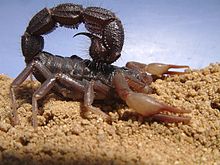- Parabuthus transvaalicus
-
Parabuthus transvaalicus 
Scientific classification Kingdom: Animalia Phylum: Arthropoda Class: Arachnida Order: Scorpiones Family: Buthidae Genus: Parabuthus Species: P. transvaalicus Binomial name Parabuthus transvaalicus
(Purcell, 1899)Parabuthus transvaalicus is a species of scorpion from southern Africa. It is also known as "Dark Scorpion".
Contents
Description
P. transvaalicus grows to a length of 90–110 millimetres (3.5–4.3 in), and is dark brown or black in colour.[1] Its pincers are thin, but its tail is thickened, with the sting segment being as wide as the rest of the tail.[1] It is nocturnal, resting in a shallow burrow under rocks during the day.[1] It resembles Parabuthus villosus, which is less strictly nocturnal, hairier and has a more westerly distribution.[1]
Distribution
P. transvaalicus is found in deserts, scrublands and semi-arid regions of Botswana, Mozambique, Zimbabwe and South Africa.[2]
Sting
P. transvaalicus is a dangerous scorpion, which can both sting and spray its venom.[1] The first droplet of venom differs from the rest, and is referred to as "pre-venom".[3]
References
- ^ a b c d e Vincent Carruthers (2005). "Spiders and other arachnids". The Wildlife of Southern Africa: A Field Guide to the Animals and Plants of the Region. Struik. pp. 14–27. ISBN 9781868724512. http://books.google.co.uk/books?id=QygFIjP9jYUC&pg=PT40.
- ^ Jan Ove Rein (2010). "Parabuthus transvaalicus (Purcell, 1899)". The Scorpion Files. Norges Teknisk-Naturvitenskapelige Universitet. http://www.ntnu.no/ub/scorpion-files/p_transvaalicus.php. Retrieved November 2, 2010.
- ^ Bora Inceoglu, Jozsef Lango, Jie Jing, Lili Chen, Fuat Doymaz, Isaac N. Pessah & Bruce D. Hammock (2003). "One scorpion, two venoms: prevenom of Parabuthus transvaalicus acts as an alternative type of venom with distinct mechanism of action". Proceedings of the National Academy of Sciences 100 (3): 922–927. doi:10.1073/pnas.242735499.
Categories:- Buthidae
- Invertebrates of Africa
- Animals described in 1899
Wikimedia Foundation. 2010.
